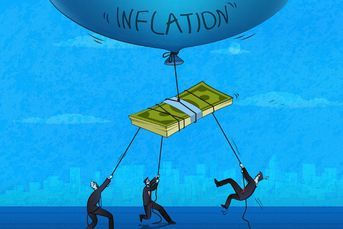Goldman likes stocks, but Morgan Stanley senses danger
Treasury yields below zero on an inflation-adjusted basis for only the second time since Dwight D. Eisenhower's presidency…
Treasury yields below zero on an inflation-adjusted basis for only the second time since Dwight D. Eisenhower's presidency have split Wall Street's biggest firms, underscoring the relative-value dilemma that equity investors face following the biggest first-quarter rally in 14 years.
For Peter Oppenheimer, The Goldman Sachs Group Inc.'s chief global equity strategist, the fall of yields on 10-year Treasuries to about -0.3% when the rate of inflation is deducted means that U.S. stocks offer a once-in-a-generation buying opportunity.
But Morgan Stanley's Adam Parker advises caution, saying that the Federal Reserve stimulus that has led the fixed-income rally can't last forever.
Job growth last month, which was lower than estimated by economists in a recent Bloomberg survey, underscored how much the economy has relied on the Fed's help since the financial crisis began in 2007.
At the same time, record-low yields on Treasuries are driving investors to riskier assets such as stocks, said Howard Ward at Gamco Investors Inc.
“Capital will chase returns,” said Mr. Ward, who helps oversee $35 billion as chief investment officer of growth equities.
“There's a tremendous shortage of investment income and there are fewer places to go to generate that,” he said. “Stocks are to a large extent the only game in town for earning a respectable return.”
Mr. Ward favors technology companies such as Apple Inc. (AAPL), Microsoft Corp. (MSFT) and Qualcomm Inc. (QCOM), given their earnings potential, as well as consumer stocks with emerging-markets operations such as Nike Inc. (NKE) and Starbucks Corp. (SBUX).
WEEKLY DECLINE
Equities fell during the trading week ended April 13, driving the S&P 500 down 2% to 1,370.26 in its first back-to-back decline since November, after the government reported that American employers added 120,000 jobs in March, fewer than estimated by the 79 economists in the Bloomberg survey.
The index had declined about 3.4% as of April 13 from its four-year high April 2, trimming gains of as much as 29% in the past six months, after the Fed said that it won't add more stimulus unless the economy falters or inflation tops its 2% target.
The central bank already has bought $2.3 trillion of bonds in two rounds of asset purchases and started a $400 billion program known as Operation Twist to replace short-term debt in its holdings with longer-term securities. Yields on 10-year Treasury notes fell below 2% during the week ended April 13 after reaching a five-month high of 2.4% last month.
CONSUMER PRICES GAIN
Consumer prices excluding food and energy rose at a 2.3% annual rate last month, the government said April 13. Yields on 10-year Treasuries were at 1.98% as of that date.
Benchmark 10-year Treasuries have yielded less than zero on an inflation-adjusted basis at the end of every month since November as concern that Europe's debt crisis would derail the global economic recovery pushed investors to the safety of government debt.
As of April 13, U.S. bonds had returned 9.61% since Dec. 31, 2010, according to Bank of America Merrill Lynch indexes. The S&P 500 had added 12%, including dividends.
With bonds so expensive, prospects for stock returns are “as good as they have been in a generation,” Mr. Oppenheimer wrote in a March 21 report.
Share prices are too low, given the economic outlook, he wrote.
Mr. Oppenheimer recommends shares of global energy companies, Japanese industrial stocks and U.S. tech corporations, according to an April 10 note.
FED MODEL
Equities are close to the cheapest level ever, relative to debt, even after the S&P 500's biggest first-quarter rally since 1998, according to the so-called Fed model, which compares the earnings yield for stocks with Treasury rates.
Profits for S&P 500 companies have represented 7.16% of the index's price on average this year, or 5.13 percentage points more than yields on 10-year Treasuries, according to Fed model data compiled by Bloomberg. That compares with the average difference of 0.03 percentage points and the record high of 6.99 points when the bull market started in March 2009, according to data compiled by Bloomberg going back to 1962.
“This is a very attractive time for equities, especially relative to bonds,” said Abby Joseph Cohen, senior U.S. investment strategist at Goldman Sachs.
After three decades of declines, “it's hard to see how interest rates are going to go down much more and stay there for a long period of time,” she said.
Ms. Cohen said that she likes stocks with increasing dividends in groups such as technology.
David Kostin, the firm's chief U.S. equity strategist, recommends energy and tech companies.
“DANGEROUS ASSETS’
Warren E. Buffett, chairman of Berkshire Hathaway Inc. and the third-richest person in the Bloomberg Billionaires Index, said in February that low interest rates and inflation have made bonds “among the most dangerous of assets.”
The last time that real yields were negative was in 1979-80, when Fed Chairman Paul Volcker fought runaway inflation by raising borrowing costs. The same acceleration in consumer prices that he targeted also pushed 10-year Treasury yields below the so-called core inflation rate at the end of 1970 and in 1974-75.
American consumer prices, excluding food and energy, rose 13.3% in May 1980, 3.1 percentage points more than bonds.
In 1958, during the Eisenhower presidency, real yields were negative, according to the International Monetary Fund.
Fed Chairman Ben S. Bernanke has left the benchmark rate near zero since 2008 to spur inflation and lure investors into riskier assets as an effort to help restore the 8.7 million jobs lost during the recession that ended in 2009.
“If you're looking at real yields' being zero, what that implies is that the market doesn't expect a whole lot of real economic growth,” said Wayne Lin, a money manager at Legg Mason Inc.
His firm oversaw $643 billion as of March 31.
“It's negative for equities. Multiple expansion, earnings growth — all that is driven by economic growth,” Mr. Lin said.
For his part, Mr. Parker said that the economy has yet to prove it can grow without the Fed's help, posing a risk to equities.
The central bank's attempt to eliminate the threat of deflation with unprecedented stimulus won't boost the stock market forever, according to Mr. Parker, Morgan Stanley's equity strategist.
Managers at DoubleLine Capital LP, Loomis Sayles & Co. LP and Pacific Investment Management Co. LLC, which collectively oversee about $1.5 trillion, expect a third round of Fed bond purchases as signs of economic strength fade and Europe's sovereign-debt crisis worsens.
Gross domestic product will expand 2.3% this year, down from 3% in 2010, according to economist estimates compiled by Bloomberg.
“COMBAT CRISES’
“When rates are extremely low or extremely high, it's usually because policy has been enacted to combat crises,” Mr. Parker said.
“Equities work when real rates are in some healthy band like 3% to 5%. That's when you should be bullish,” Mr. Parker said.
“If you have extremely low or high real rates, it's usually a systemic problem that takes a long time to fix,” he said.
Mr. Lin and Mr. Parker favor companies that pay high dividends.
The S&P 500's dividend yield has averaged 2% this year, about the same as rates on 10-year Treasuries. Bonds usually have the advantage, offering yields more than two times higher on average since 1971, data compiled by Bloomberg show.
Although telephone and utilities stocks historically have offered higher payouts, consumer companies from Gannett Co. (GCI) to Leggett & Platt Inc. (LEG) are among the top 25 S&P 500 companies ranked by yield, data compiled by Bloomberg show.
Gannett, the owner of newspapers including USA Today, raised its quarterly payout this year to 20 cents a share, from 8 cents, lifting the company's yield to 5.33%. The stock has risen about 67% since Oct. 3, including dividends, compared with a gain of 0.03% for Treasuries, data compiled by Bloomberg and Bank of America Corp. show.
Leggett & Platt, a maker of bedding and chair components, is yielding double its average since 1980, data compiled by Bloomberg show. The stock has returned about 23% since Oct. 3, including dividends.
Shares rallied April 12 after Fed Vice Chairman Janet Yellen and William C. Dudley, president of the Federal Reserve Bank of New York, endorsed the view that borrowing costs will stay low through 2014.
It is “still too soon to conclude that we are out of the woods,” Mr. Dudley said in an appearance at Syracuse University that day.
Although the economy is still recovering, stocks are attractive, according to Byron Wien, vice chairman of the advisory services unit at Blackstone Group LP, the world's biggest private-equity firm.
“The low-interest-rate environment is the attempt by the Fed to encourage faster growth and therefore lower unemployment,” he said. “The question is: Can the economy develop a natural momentum on its own? And that question is still open.”
Learn more about reprints and licensing for this article.








